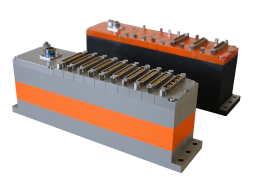
Axon Data Acquisition System (DAS) used in test flights of Suborbital Technology Carrier-8 suborbital sounding rockets
ASHBURN, Va. – April 28, 2020 – Curtiss-Wright’s Defense Solutions division, a trusted leading supplier of flight test instrumentation (FTI) system solutions, today announced that its highly rugged Axon data acquisition system was successfully deployed in the first night-time test flights of NASA’s Suborbital Technology Carrier-8 sounding rocket program, for which Northrop Grumman has the prime contractor role. On October 24, 2019, NASA conducted the first successful night-time launch of the Suborbital Technology Carrier-8. During the test flights, Curtiss-Wright’s Axon FTI system was used to capture experimental data from the rocket’s onboard sensors. After acquiring the data, the Axon system conditions and packages the data prior to sending it on to a transmitter.
"We are very proud that our next-generation Axon data acquisition technology was selected by NASA to support this important-sounding rocket program,” said Lynn Bamford, President, Defense, and Power Segments. “High performance in the harsh conditions typical to suborbital flight applications demands a highly rugged, reliable solution like Axon. This compact DAU delivers the high acquisition speed that space launcher programs require.”
About NASA’s Sounding Rockets Program
Sounding rockets are cost-effective platforms for suborbital experiments since they do not need expensive boosters or extended telemetry and tracking coverage. In addition to being low-cost, sounding rocket mission payloads can be developed in a very short time frame -- sometimes as quickly as 6 months. This enables scientists to react quickly to new phenomena and to incorporate the most up-to-date technology in their experiments. Sounding rockets are used to carry small scientific instruments into space along a parabolic trajectory. Their overall time at the edge of space is brief, typically 5-20 minutes, and at lower vehicle speeds for a well-placed scientific experiment. The short time and low vehicle speeds are more than adequate (in some cases they are ideal) to carry out successful scientific experiments. Furthermore, there are some important regions of space that are too low for satellites and thus sounding rockets provide the only platforms that can carry out measurements in these regions.
About the Axon Product Family
The Axon product family is the most advanced airborne data acquisition system available today, offering low size, weight, and power (SWaP) with the best feature set, data acquisition, and thermal performance on the market. The Axon product family builds on Curtiss-Wright’s heritage as the leading supplier of rugged reliable data acquisition for aerospace applications. Axon’s future proof design, using a high-speed serial backplane (1 Gbps dedicated link per module), ensures future high data rates are supported. Its low SWaP design means it can be located in tight spaces and operate reliably without requiring bulky heatsinks.
This design also allows any of the Axon family user modules to be placed in ultra-miniature "Axonite" housings and located remotely, separated from the chassis by up to 10 meters. When acquiring and digitizing sensor data, the closer the DAU is to the sensor, the better the data quality since the likelihood of external noise affecting the signal is greatly mitigated. The use of remote Axonites, located closer to the sensors, delivers improved data quality compared to running sensor wires directly back to the main DAU chassis. Locating data acquisition closer to the sensors can also significantly decrease the installation time and cost of the instrumentation while simultaneously reducing wiring weight. What’s more, Axonites can deliver significant system cost savings in larger installations by reducing the number of DAUs required in remote locations, thus cutting down on extra chassis, controller, and power supply costs.
Curtiss-Wright designs the DAU module products covered by this agreement at its Aerospace Instrumentation facilities in Newtown, Pennsylvania, and Dublin, Ireland. The products, currently manufactured at the Dublin facility, are being shipped to the NASA Wallops Flight Facility in Wallops, Virginia.
About Curtiss-Wright Corporation
Curtiss-Wright Corporation is a global innovative company that delivers highly engineered, critical function products and services to the commercial, industrial, defense and energy markets. Building on the heritage of Glenn Curtiss and the Wright brothers, Curtiss-Wright has a long tradition of providing reliable solutions through trusted customer relationships. The company is headquartered in Davidson, N.C., and employs approximately 9,100 people worldwide. For more information, visit www.curtisswright.com.
###
Note: Trademarks are property of their respective owners.
